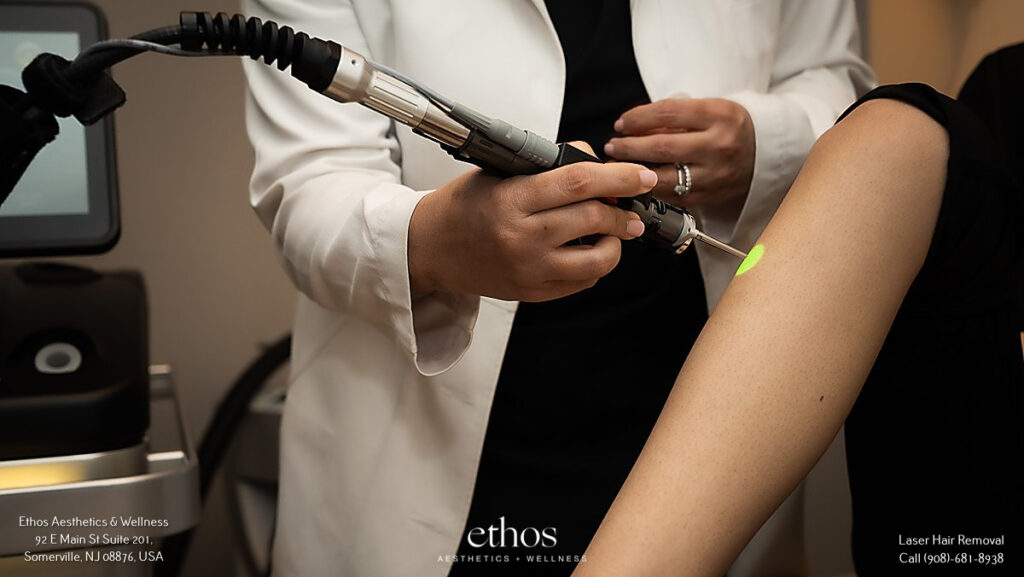At Ethos Spa, we understand that transitioning gender is a deeply personal and liberating journey. For many transgender women, achieving feminine traits like smooth, hair-free skin is crucial in realizing their true gender identity.
That’s why we offer customized laser hair removal tailored to the unique needs of trans women. Our licensed doctors and experienced technicians stay current on the latest technologies to ensure safe, effective, and permanent hair reduction for all skin types.
Let’s answer all your questions, then!
Is laser hair removal for transgender individuals effective?

Laser hair removal is highly effective for permanently reducing unwanted hair growth in transgender individuals when performed properly over multiple sessions.
- According to a 2021 study, laser hair removal led to an average 66% reduction in hair growth over an average of 7 treatments.
- Another study found that after laser hair removal treatments prior to gender affirmation surgery, 77% of patients rated their outcomes as “much better” or “very much better”.
- The face and neck are common areas for laser hair removal in transgender women, with 89% receiving treatment in these areas.
While laser hair removal effectively delays hair growth for long periods, it does not guarantee permanent removal.
Maintenance treatments may be needed, as some hair could be resistant or regrow after treatment. However, new regrowth tends to be finer and lighter.
On average and based on our experience, transgender laser hair removal clients see about 95% permanent reduction after 7-10 treatments.
Dr. Soni recommends the same number of initial treatments, followed by maintenance sessions as needed if dormant follicles reactivate.
What are the benefits of laser hair removal for transgender individuals?
- Permanently reduces unwanted hair growth
According to Dr. Soni’s extensive experience, laser hair removal is highly effective for permanently reducing masculine hair growth by 60-90% or more when performed correctly over a series of treatments. Repeated laser sessions damage hair follicles in all growth phases, preventing regrowth long-term.
- Prepares for gender affirmation surgery
In addition, permanent hair removal is often required as a preparatory procedure before bottom surgery and other gender confirmation procedures. Eliminating hair from surgical sites prevents complications like skin irritation, infections, and suboptimal cosmetic results.
- Alleviates gender dysphoria
For many transgender patients, removing unwanted masculine hair patterns relieves gender dysphoria and supports alignment with their female identity. Patients often describe laser hair removal as life-changing for this sole reason.
- Saves time and money
Permanent hair removal saves transgender women time, discomfort, and money compared to temporary methods like shaving or waxing that must be frequently repeated.
- Prevents irritation
Additionally, laser hair removal prevents irritation from ingrown hairs and razor bumps commonly caused by shaving sensitive areas.
- Allows smooth skin year-round
It allows for maintaining consistently smooth, stubble-free skin year-round for confidence and comfort.
What’s the process of laser hair removal for MTF individuals?
The process involves using laser light pulses targeted at hair follicles to damage them and significantly slow hair regrowth over 6-10 treatments spaced 4-8 weeks apart for optimal results.
We tailor the laser hair removal process specifically for transfeminine patients to ensure maximum comfort and results.
- Before your first session, we’ll evaluate your medical history and medications, especially hormone replacement therapy, to determine the right laser settings. We’ll also assess your skin tone, hair color, and treatment areas to customize the process.
- When you arrive, we’ll have you change into a gown and protective eyewear for your safety and comfort. A topical numbing cream can be applied if desired to minimize pain. Dr. Soni will then precisely administer laser pulses across each area to damage the hair follicles.
- You may experience some mild stinging or heat sensations as the laser targets the hair roots. Treatments usually take 15-45 minutes depending on the size of the area. 4-8 weeks between each session allows damaged follicles to shed and new hairs to enter the growth phase for targeting.
After each visit, we advise avoiding sun exposure and using aloe vera gel to soothe any irritation. Mild redness and swelling typically subsides within 12-24 hours. Ingrown hairs can occur during the hair-shedding process but can be managed with proper skincare.
Are there specific laser hair removal procedures for male-to-female transgender individuals?
There are no laser procedures specific to male-to-female individuals, but typical areas treated include the face, chest, back, arms, legs, and genital region to feminize appearance. Oftentimes, there will be specific requirements for hair removal related to bottom surgery.
Dr. Soni emphasizes the importance of thorough hair removal for transgender women preparing for gender affirmation procedures like the one mentioned. Constructing the neovagina from penile and scrotal skin requires clearing hair follicles to prevent undesirable outcomes.
Why such meticulous hair removal beforehand? Well, any lingering hair inside the newly created vaginal cavity risks serious complications. Post-surgical hair growth could cause infection, pain during intercourse, discomfort from internal hairballs and tugging sensations, and subpar cosmetic results.
To avoid these problems, surgeons require patients to undergo 6-12 months of hair removal treatments on specific areas before surgery. This includes the penile shaft, scrotum, perineum near the anus, and sometimes skin graft donor sites like the thigh or forearm.
Dr. Soni knows how to safely leverage laser hair removal for proper pre-surgical preparation.
Hair removal should be completed at least 3 months before surgery so the genital skin has time to fully heal before reshaping it into a neovagina. This minimizes risks like infection or wound separation after surgery.
Trust us to expertly clear hair from surgical sites for your peace of mind.
How does hormone replacement therapy (HRT) affect laser hair removal?
Hormone replacement therapy can stimulate some hair regrowth over time, requiring occasional touch-up laser hair removal treatments, though it also slows and reduces hair growth overall.
- Those on masculinizing HRT like testosterone may see faster and increased hair regrowth after laser treatments. This is because the excess hormones stimulate new follicle activity. More repeat laser sessions may be needed to keep up with growth.
- On the other hand, feminizing HRT using anti-androgens and estrogen can help reduce and thin out body and facial hair over months or years. HRT alone is often insufficient for complete hair removal, though.
Additional laser or electrolysis treatments are usually recommended for achieving the desired smoothness.
According to our experience, every transgender woman responds differently to HRT based on genetic, hormonal, and medication differences. So results will definitely vary.
Overall, studies show laser and electrolysis remain safe and effective hair reduction options alongside HRT. However, the treatment course may need to be extended compared to those not on hormones.
For best outcomes, Dr. Soni suggests completing laser hair removal first, before initiating HRT. This allows targeting all hair follicles in their natural state. If HRT is started first, it can spur new growth that requires more laser sessions to remove. Proper timing helps set his transgender patients up for success.
What is the recovery process like after MTF laser hair removal?
The laser hair removal recovery process for trans women involves minimal downtime with possibly some redness lasting 24-48 hours that can be treated with aloe vera gel or vitamin E oil. Hairs shed over 2 weeks. Additional treatments for facial and body areas continue reducing hair growth over the succeeding weeks and months.
Side Effects to Watch Out For
- Redness, swelling, irritation, and discomfort are common side effects immediately after treatment. These typically resolve within a few hours to days. Using cool compresses can help soothe the skin.
- Other potential side effects include pigment changes, blistering, scabbing, and rarely, scarring or burns. Properly caring for skin after treatments can help minimize risks.
Other Aftercare Guidelines
- Avoid sun exposure and tanning for at least 2 weeks after to prevent burns, irritation, and hyperpigmentation.
- Refrain from taking hot showers, baths, saunas, and activities causing friction for 24-48 hours. Lukewarm water is recommended.
- Gently cleanse skin but avoid scrubbing. Allow any scabs to heal naturally. Exfoliate gently once redness subsides, about 1-2 weeks after.
- Avoid lotions with fragrances for 24 hours.
- Wait 24 hours before applying makeup. Wait 2+ days before shaving again. Avoid waxing, tweezing, etc. during the treatment course.
What is the cost of laser hair removal for transgender individuals?
Laser hair removal costs $200-$400 per treatment session with 6-10 sessions needed, so total costs often reach several thousand dollars. You’ll have to be mindful of the following factors when considering your budget:
- Size of the area being treated: Larger areas like the back, chest, or legs cost more than smaller areas like the upper lip or chin. Full-face treatments range from $200-$1000 alone.
- Number of sessions required: Some patients require even up to 10 sessions for optimal results. The total cost is determined by the per-session price multiplied by the number of sessions.
- Hair and skin color: Dark hair on light skin responds best. More sessions are needed for lighter hair or darker skin, increasing costs.
- Geographic location: Prices are generally higher in affluent, metropolitan, or coastal areas compared to rural or suburban areas due to higher business operating costs.
- Provider expertise: More experienced providers with specialized training tend to charge higher fees. Discounts may be offered at training clinics with less seasoned staff.
- Type of laser equipment: Newer, more advanced laser technology costs more per session than older equipment.
- Package pricing: We sometimes offer discounted rates for purchasing multiple sessions in advance or treating multiple body areas in one visit.
Does insurance cover laser hair removal for transgender patients?
Insurance coverage for transgender laser hair removal is expanding but remains inconsistent, with 16-40% of plans providing some degree of coverage, most often only pre-operatively.
Unfortunately, only about 5% of health plans currently cover this procedure, often classifying it as a cosmetic treatment.
In rare cases, coverage may be approved for facial hair removal or clearing genital areas prior to gender confirmation surgery but is typically limited to just 6 sessions. Medicaid and ACA plans offer the least coverage compared to private insurance.
However, states with legal protections for transgender health services increase the chances of getting coverage. Even then, appeals and letters of medical necessity are usually required if denied initially.
For those unable to get insurance reimbursement, know that some nonprofit healthcare providers can offer financial assistance based on income level and need.
Are there laser hair removal clinics that are transgender-friendly?

There are clinics with staff experienced in caring for transgender patients in a welcoming, respectful environment. These qualities are needed for stellar laser hair removal treatment and results.
At Ethos Spa, we pride ourselves on being an inclusive and transgender-friendly clinic. Our staff is specially trained to provide excellent clinical care while also creating a respectful, safe environment for trans patients.
We use correct names and pronouns, offer private changing rooms, and have zero tolerance for any judgment or harassment. Under the expert guidance of Dr. Soni, our clinic has years of experience successfully treating transgender women with laser hair removal.
Invest in Lasting Confidence
We’re well-aware that undergoing laser hair removal is an important step for many in their transition journey. Our team supports you each step of the way with safe, customized treatments using advanced technology.
Contact us today to start building confidence that comes from embracing your true self.







